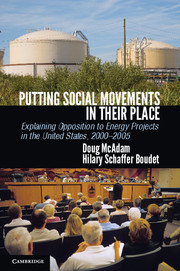 Putting Social Movements in their Place
Putting Social Movements in their Place Book contents
- Frontmatter
- Contents
- Acknowledgments
- 1 From Copernicus to Ptolemy and (Hopefully) Back Again
- 2 Comparing Communities “At Risk” for Mobilization
- 3 Explaining Variation in the Level of Opposition to Energy Projects
- 4 Does Opposition Matter?
- 5 From Not in My Backyard to Not in Anyone’s Backyard
- 6 Back to the Future
- Appendix A Additional Community Data Collected Not Used in Causal and Outcome Condition Scoring
- Appendix B Raw Data and Methods for Scoring Causal Conditions
- Appendix C Interview Sources by Case
- Bibliography
- Index
2 - Comparing Communities “At Risk” for Mobilization
Published online by Cambridge University Press: 05 June 2012
- Frontmatter
- Contents
- Acknowledgments
- 1 From Copernicus to Ptolemy and (Hopefully) Back Again
- 2 Comparing Communities “At Risk” for Mobilization
- 3 Explaining Variation in the Level of Opposition to Energy Projects
- 4 Does Opposition Matter?
- 5 From Not in My Backyard to Not in Anyone’s Backyard
- 6 Back to the Future
- Appendix A Additional Community Data Collected Not Used in Causal and Outcome Condition Scoring
- Appendix B Raw Data and Methods for Scoring Causal Conditions
- Appendix C Interview Sources by Case
- Bibliography
- Index
Summary
Social movement scholars have long faced a methodological dilemma familiar to social scientists. We refer to the stark choice between two research methods that are, in their respective strengths and weaknesses, mirror images of one another. The choice is between “thin” large N studies that allow researchers to generalize to broader populations versus “thick” case studies that yield a rich, holistic understanding of the phenomenon in question, but without being able to tell us anything about the representativeness of the specific case on offer. These two options do not exhaust the methodological strategies available to movement researchers, but a broad scan of the extant empirical work on social movements would, we are convinced, show that these two approaches have been broadly modal in the field throughout the past thirty years.
The single case study has been especially popular with social movement scholars. A partial list of classic studies of single movements would include Adam (1987) on the gay and lesbian movement; Jenkins (1985) and Ganz (2009) on the farmworkers movement; Morris (1984), McAdam (1999 [1982], Luders (2010), and Andrews (2004) on the U.S. civil rights movement; Costain (1992), Rupp and Taylor (1987), Banaszak (1996), Evans (1979), and Mansbridge (1986) on various “chapters” or movements in the history of U.S. feminism; Amenta (2006) on the Townsend movement; Parsa (1989) and Arjomand (1988) on the Iranian Revolution; Meyer (1990) on the nuclear freeze movement; Smith (1991) on liberation theology; Schwartz (1976) on the Southern Farmers’ Alliance; McVeigh (2009) on the resurgent Ku Klux Klan during the 1920s; Gould (2009) on ACT UP (AIDS Coalition to Unleash Power); and Walder (2009b) on the Beijing Red Guard movement. The fact that we could easily double or triple this list of citations only serves to make our point: it is probably fair to say that the case study has been the central arrow in the methodological quiver of social movement scholars.
- Type
- Chapter
- Information
- Putting Social Movements in their PlaceExplaining Opposition to Energy Projects in the United States, 2000–2005, pp. 28 - 53Publisher: Cambridge University PressPrint publication year: 2012


